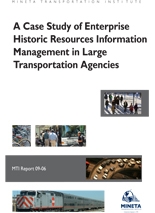- 408-924-7560
- mineta-institute@sjsu.edu
- Donate
A Case Study of Enterprise Historic Resources Information Management In Large Transportation Agencies
Historic resources are in some way managed by every transportation agency in the nation. Transportation agencies manage historic and prehistoric archaeological sites, buildings, structures, objects, routes, landscapes, and districts to prevent damage to such resources and to mitigate damage when it is unavoidable. In order to track known resources, transportation agencies often keep local files in a variety of forms, rely upon external sources of information (e.g., historic preservation agencies at the state level), and depend upon staff expertise gained by years of local work.
Starting in 1997, Caltrans started a series of surveys of rural rights of way in its district offices. This work, which is still on-going, created fairly similar sets of digital data within approximately half of the agency´s district offices. The GIS datasets and relational database management systems are roughly similar between offices, but not identical.
The present study focuses on defining how the district office information systems for historic resources can (and cannot) be used to create an enterprise information management model specific to historic resources within Caltrans. Results of this study range from findings specific to Caltrans and its district offices to general findings that should apply to any transportation agency contemplating an enterprise-wide system for managing cultural resources.
Eric E. Ingbar
Eric E. Ingbar has been a professional archaeologist and cultural resource specialist for over 20 years. He is a founding principal of Gnomon, Inc., a business firm specializing in creating, implementing, and maintaining information systems for managing resources and infrastructure, including cultural resources, other natural resources, and proposed land uses. He manages projects, directs staff in the technical and professional arenas, and serves as a lead analyst on GIS projects. Ingbar and Gnomon, Inc. are primary IT consultants to many state historic preservation offices, creators of the successful large-scale pilot use of GPS and GIS within Caltrans, consultant to the Bureau of Land Management (BLM) for multi-agency data sharing and nationwide technical assistance, and recipients of multiple successful agency automation and study projects. He also serves as an advisor to two different Federal Highways projects pertaining to automation of cultural resources information and environmental streamlining.
Ingbar earned his BA in social anthropology from Swathmore College, graduating with honors in 1979, and his MA in anthropology from the University of New Mexico, also graduating with honors, in 1983.
-
Contact Us
San José State University One Washington Square, San Jose, CA 95192 Phone: 408-924-7560 Email: mineta-institute@sjsu.edu






